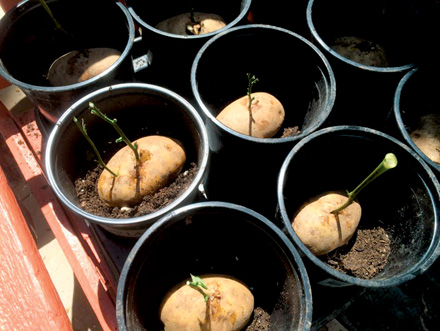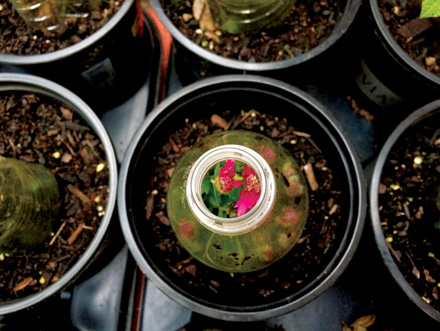Cloning Roses

You probably have seen the same videos that caught my attention, ones showing how to clone roses by planting them in potatoes.
I thought about those videos as I was enjoying a friend’s son’s wedding earlier this summer. The table decorations were beautiful bowls of pink and white roses. As I was leaving the wedding venue, I thought why not take this opportunity to see if this cloning process works. If it does, I could give a cloned rose to the bride as a wedding memento. I also suspected my friend, mother of the groom, would love to have a start. It would be an unusual but sweet memory of the lovely Kansas City weekend.
I collected a dozen clear plastic water bottles without lids. I used the same size bottles so I could monitor if there was one type of rose that did better than another one. I also purchased a bag of large russet potatoes and dusted off a dozen clean plastic pots in a tray. Adding bagged potting soil, I trimmed off rose leaves, dipped the newly-cut rose stems in rooting hormone and eased them into the potato holes before covering with soil and watering. In some cases, the rose stems were shorter than the recommended six-eight inches. I used them anyway, making sure growing nodes were covered by soil.
I don’t have a clue what kind of roses they were. They were provided by a florist, which means they may not be patented and were grown overseas.
In researching rose cloning, I discovered a glitch. Some roses offered for sale in the US are patented, which means only the person holding the patent has the right to asexually reproduce the plant. Much like videos that are copied without permission, rose breeders hold the rights to their registered roses. Cloning the rose, especially for sale, is illegal and denies the rose breeders their rights to make money.
Rose patents are good for 20 years. Any rose introduced within the last 20 years is also probably patented. To stay out of trouble, it is best to only propagate rose varieties that are at least 20 years old.
I placed the tray of pots on a bench on the north side of my house. The north side gets some sun but not the hot afternoon, burning sun. I also made sure the pots had water, and checked on their moisture every day.
Growing roses has become less popular among gardeners, according to my friends at area nurseries. One brand of continuously-blooming rose with little care has knocked the more traditional, scented roses off the market. Too bad because I still have old hybrid tea and miniature roses that bloom continuously once they start, adding a lovely scent to my garden. I also enjoy feeding them a mixture of egg shells, dried banana peels, Epsom salts and dried coffee grounds during their growing season. One of my hybrid teas is more than 30 years old.
After several weeks, I couldn’t wait any longer so I peeked under the clear plastic bottle domes. Sure enough, it was working. I was growing very green, and very healthy, potatoes.
Charlotte Ekker Wiggins is a certified gardener, beekeeper and sometimes cook. Copyright 2016 used with permission, all rights reserved. This material may not be published, broadcast, rewritten or redistributed. Contact Charlotte at chargardens@gmail.com.

ROSE START? – The rose stems were dipped in rooting hormone and inserted in a hole I made in the Russet potatoes sitting in potting soil. The plastic clear water bottles with the bottoms cut out become the little moisture-controlling domes after the pot is filled with potting soil.
 MUM, YES – This process didn’t work for roses but it looks like I succeeded in getting a little start of pink Chrysanthemums going. They root easily in water and soil so don’t be too impressed. I am excited to have something other than potatoes growing. (Photos by Charlotte Ekker Wiggins).
MUM, YES – This process didn’t work for roses but it looks like I succeeded in getting a little start of pink Chrysanthemums going. They root easily in water and soil so don’t be too impressed. I am excited to have something other than potatoes growing. (Photos by Charlotte Ekker Wiggins).



Facebook Comments